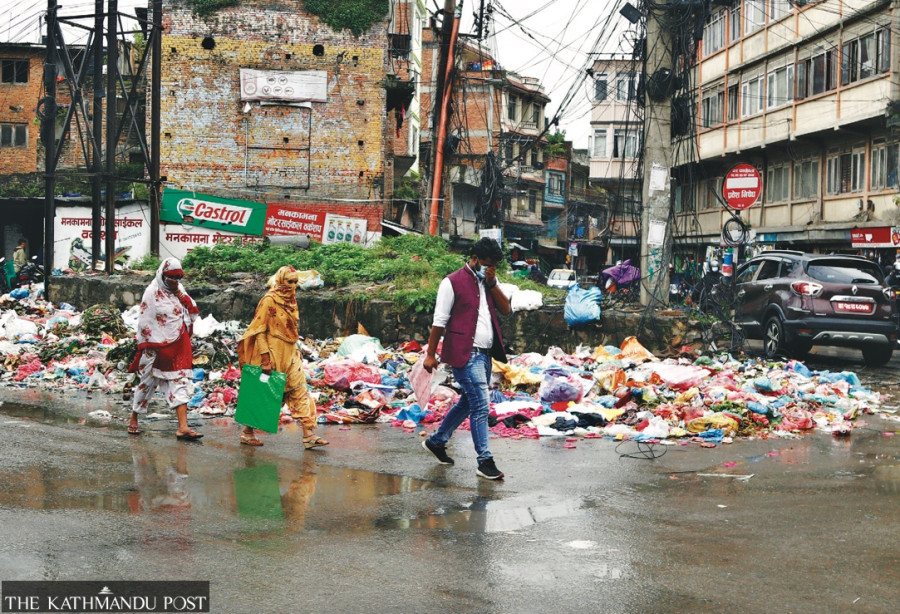Valley
While Kathmandu stinks, its mayor is running a musical campaign
Kathmandu Metropolitan City officials say the road to Sisdole landfill site has been damaged by rains so garbage won’t be picked up until the rains stop.
Anup Ojha
Thursday was the 11th day that the Kathmandu Metropolitan City had not collected garbage. City officials say they are still unable to say when they will be able to resume garbage pickup.
Heaps of garbage have been piling up on the roadsides, back alleys, open spaces and people’s homes in the Capital city.
“The City will be able to pick up garbage only when it stops raining,” said Ishwor Man Dangol, spokesperson for the City office. “Some parts of the road to the Sisdole dumping site have been damaged by rains and the landfill site itself is currently flooded making it impossible for lorries to get in.”
Garbage management is a perennial problem in Kathmandu. Every year during the rainy season, the problem returns and the City officials give the same reasons due to which the metropolis has often faced criticism for failing to do its most basic duty of managing garbage.
“We can’t solve the garbage problem until the Ministry of Urban Development hands over the Banchare Danda landfill as an alternative. We have been asking the ministry to open Banchare Danda as soon as possible,” said Dangol.
While the national capital stinks with rotting garbage, the City office, however, has its focus elsewhere. On Wednesday, it launched a new campaign hoping to recover unpaid taxes from defaulting businesses and organisations. As part of the campaign, the City office has deployed a troupe of female musicians accompanied by City police personnel who have been visiting the businesses and organisations concerned, playing loud music and pasting tax notices on their complexes.
“The issue here is Kathmandu Metropolitan City, the wealthiest among all local bodies in the country, failing to fulfil its basic duty of managing garbage and fixing the basic infrastructure including roads and drainage. There are so many problems that need attention but the City is busy in ridiculous activities like deploying a musical troupe to serve tax notices to the defaulters,” said urban planner Suman Meher Shrestha.
Shrestha gave examples of Europe and the United States saying how people there feel proud to pay their taxes.
“This is because the governments there do not compromise on their duties and responsibilities to their citizens but that’s not the case in a developing country like ours,” said Shrestha.
This year the City unveiled a budget of Rs18.9 billion. For garbage management, it has allocated Rs240 million to pay for the fuel of the lorries that transport garbage and the salaries of the drivers and other staffers, according to Hari Bahadur Shrestha, chief of the Environment Division of the City.
“The City has more than enough budget, but why can’t it make alternative arrangements for garbage management?” said Shrestha, the urban planner.
While the City officials say the garbage problem has been caused by the lack of a proper landfill site, Sumitra Amatya, a waste management expert and town planner, says landfill sites can never be a solution to Kathmandu’s solid waste.
“Landfill sites are an outdated idea which the developed countries had practised some six decades ago. Now the waste should be segregated and recycled,” said Shrestha.
The City has separate laws regarding solid waste management in the form of Solid Waste Management Act 2011 that requires local bodies to ensure the separation of solid waste into at least organic and inorganic waste at its source. However, the City has never been able to implement the law.
Every day, Kathmandu Valley generates around 1,200 tonnes of solid waste, of which nearly 600 tonnes comes from Kathmandu alone. The landfill site at Sisdole, around 27 km southwest of Kathmandu, is spread over 740 ropoanis (37.65 hectares). Initially a gorge, Sisdole has turned into a garbage mountain and exceeded its capacity years ago.
The site has become a stinking hill and the nearby settlements have complained of numerous hazards to human health and livestock and drop in the quality of agricultural produce.
Every year the Kathmandu Metropolitan City says it has started a new segregation plan but that does not work at all due to lack of proper implementation mechanisms. Last year, in January the City had started a waste segregation pilot project from Naradevi in Ward 18, with an awareness march, but that didn’t work out.
In 2005, the Kathmandu Metropolitan City started dumping the garbage collected from the Valley at Sisdole with an agreement that the site would be used for three years, but 15 years later garbage continues to be dumped here.
Dumping garbage into a landfill site also means leachate production, and if that gets mixed into a river or underground water, it threatens the aquatic ecosystem, and in Kathmandu there is a possibility of spreading diseases, according to Amatya, the waste management expert.
The City’s environment department chief Shrestha says over 75 percent of the solid waste generated from Kathmandu Valley is biodegradable.
“Of the remaining 25 percent, 15 percent waste can be reused or recycled and there will be only 10 percent solid waste we need to manage,” said Shrestha.
Although the City officials appear to have a fair idea on how to manage its waste, their plans remain unimplemented.
Urban planner Shrestha, meanwhile, suggested that Kathmandu residents should take up the garbage issue seriously.
“What if people visited Mayor Bidya Sundar Shakya’s residence with a musical troupe and bullhorns to remind him about the garbage problem and the broken urban infrastructure?” Shrestha quipped.




 10.12°C Kathmandu
10.12°C Kathmandu.jpg)











